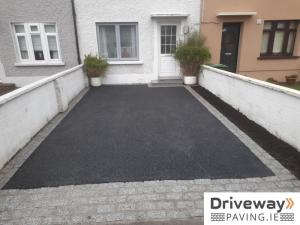As good as tarmac driveways look, at some point in time, some can begin to harbour algae and moss build-up. Tarmac by nature has gaps which often store water and are damp during colder periods of the year, especially in areas under trees or with limited sunlight. This moist area is the perfect place for moss to grow and take home.
Moss and algae growth makes the surface of your driveway unappealing, slippery, and prone to slip hazards, which is why they need to be removed as promptly as possible. Now the question arises: how to kill moss on your tarmac driveway? We have the answer right here.
In our opinion, some of the most attractive driveway choices that exist today are asphalt and tarmac, when done correctly. The elegance and the longevity of these materials make them the ideal choice for homeowners and commercial property owners alike. Easy to maintain and replace, tarmac driveways are a great option if maintained correctly. With the wide range of borders, steps, and aprons available tarmac can make a very attractive entrance to your home.

Treatment to Kill Moss and Algae
To remove the unsightly presence moss and algae , it is essential to carry out some maintenance on your driveway. Below is our list of the most effective solutions:
Chemical-Free Solution
Before jumping on to the chemical solutions which we know are easier to use for fast and effective results, we recommend you try the natural ones first. These days people are more aware of the effects the products they use on the environment. We suggest trying the natural methods first and if not successful then there are many effective chemicals which will help remove more stubborn moss and algae.
Sunlight
Moss and algae grow on damp, shaded surfaces. If you park your motor vehicle in your driveway and don’t use it often, the driveway underneath doesn’t get the direct sunlight to dry off the wet gaps and crevices.
Give your driveway some direct sunlight. This may take some days to work, but will save you from incurring unnecessary expenses in driveway repairs.
Overgrown trees and bushes may also be shading an area if youre driveway. If you notice moss and algae is growing in a specific area check if it’s shaded most of the day. Trimming the bushes or trees may solve the issue.
Boiling Water
If you are someone who cares for the environment, we have the safest option for you. Boil some water and carefully pour it over the affected area. Let the hot water do its job, then take a stiff brush and scrub the moss away. This option is good for smaller driveways or small problem areas. However it can be quite labour intensive for larger areas.
Be careful with hot water; don’t burn yourself.
Pressure Wash
The algae and moss hide between the cracks where normal water flow is unable to clean them up. For a larger area or a whole driveway a good option is a pressure washer.
Use the pressure washer to remove all the moss from the upper surface, and clean the roots as well. Make sure to sweep up the removed moss and dispose of it prevent further regrowth. This method coupled with removing overhanging vegetation is particularly effective and eco friendly.
The Safe and Effective Moss Removers
To kill moss and algae on tarmac drives, you can use some super effective methods that won’t take much time and promise guaranteed results. Below are some methods our customers have tried with success. The size of the area and severity of the moss and algae will effect your choice.
Vinegar
To remove the moss from the driveway, dilute some vinegar in water and spray it over the moss and algae deposits. Leave it for 15-20 minutes, and repeat the process for a week. Wash your driveway afterwards to remove the excess vinegar.
Jeyes Fluid
Jeyes fluid is a popular disinfectant used to remove moss, algae, and almost everything from driveways. It is the right product for removing moss from an asphalt driveway. Make sure to wash the fluid off to prevent any damage to the texture of the driveway surface.
Bleach
Bleach is also used to treat moss and algae growth. Spray it over the affected area, and remove the dead algae after it dries.
Baking Soda
Baking soda is known as one of the most effective cleaners for floors, kerbs, and driveways. It can be used in many different ways; however, the most effective and easiest method is to spread the powder over the damp area where the moss growth is visible, or the patches where the driveway looks a bit green. The baking soda will absorb all the moisture and kill the moss on the tarmac or asphalt.

How to Prevent Moss / Algae Growth: Future Maintenance of Tarmac Surfaces
Moss can be a tricky guest to handle on your tarmac driveway. Even though you know how to kill moss on your tarmac, knowing how to prevent it from coming back is also essential.
Below we have provided tips to protect against further moss attacks.
Let It Soak the Sunlight
The heat and the UV-light from the sun have a major role in controlling the reproduction of algae and moss. If your area gets a lot of rain or is usually on the colder side, this can lead to increased growth of moss.
Make sure your driveway gets enough sunlight to dry itself out and prevent further growth.
Keep an Eye Out for Moss
Even after you have done everything to kill and remove the moss, it can still come back. Keep an eye open towards any spaces that can be damp, i.e. near a faucet or where the watering can is kept. If you notice any green patches, take action immediately before it multiplies.
Handling them at the start is a simpler process compared to when the growth has spread to most of your driveway.
Wash Your Driveway
Are you wondering why washing is an option when it is going to leave the land all damp, making it the perfect spot for further growth? Well, that is not always the case. Washing the driveway is important to remove any dead moss or algae that comes in with your dirty shoes. Moss can also come in with the air or from the plants and rest in the gaps and cracks in your tarmac.
Washing it once a week or even once in two weeks would be enough to remove any chances of moss growth in the future.
Moss-Free Driveways
Killing moss from your tarmac is not only important for the look of your driveway but also your health. Inhaling or touching moss can have negative effects on your health. Now that you know how to kill moss on the tarmac, keep an eye on your driveway and use the tips discussed above to get rid of them.
Frequently Asked Questions
-
What is the best moss killer for tarmac?
The best chemical based moss killer has to be Batiface or HG Algae and mould remover. Spray the cleaner over, and leave it on for 30 minutes. It is a very strong cleaner so make sure you are well prepared. Don’t forget to wash it off right after half an hour to remove the dead algae and moss from the area. Batiface tends to leave the driveway slippery, take extra care while walking over it.
-
Does vinegar kill moss on tarmac?
Yes, vinegar is an effective moss killer on tarmac. Get rid of all the algae and moss growth from your driveway by spraying a vinegar solution over the affected area. The vinegar acts as a cleaner and dissolves all the moss and algae. Wash the driveway later to remove the leftover vinegar solution and dead moss.
-
Does Jeyes fluid kill moss on tarmac?
Yes. Jeyes fluid kills moss on tarmac driveways and acts as a disinfectant. Using a diluted solution, apply it on the driveway, then wash the solution off after 15 minutes. In this time, the jeyes fluid will do its job and the moss will be ready to scrub away.
-
How do you kill moss naturally?
You can kill moss naturally by implementing the following steps:
- Direct Sunlight: The heat dries the dampness from the area, preventing the growth of algae and moss.
- Pressure Wash: This way the reserves will be roots and debris from the gaps in the tarmac, making the regrowth of moss difficult.
- Baking Soda: Pour some baking soda over the affected area. The soda will absorb the moisture, leaving the space moss-free.
We hope our article has helped inform you about keeping your tarmac driveway free from moss and algae. With our damp climate its a common issue but is easily kept at bay with a little knowledge and time.
You can read more about our tarmac driveway services here, or view our tarmac driveways gallery.